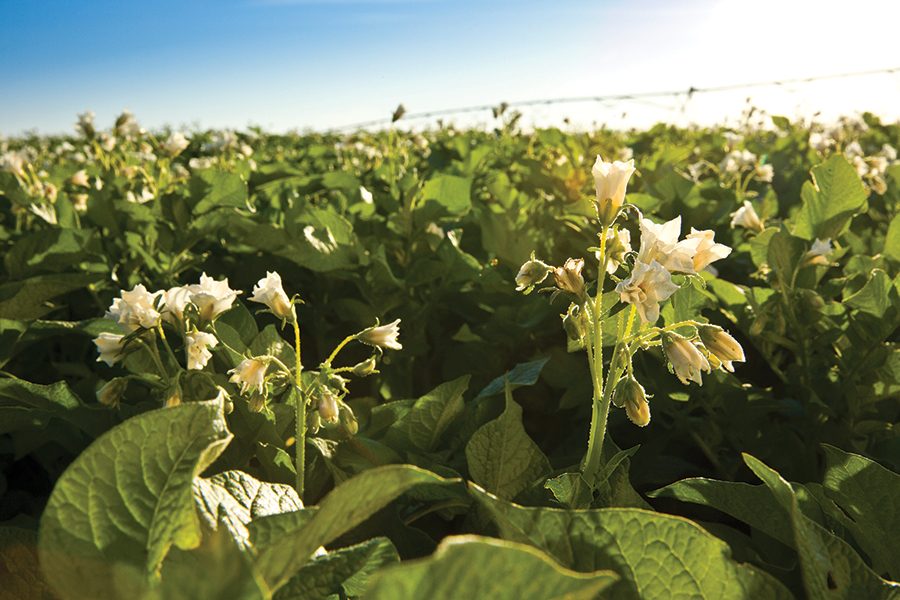
Home » ‘Perfect growing season’ is on potato farmers’ wish lists
‘Perfect growing season’ is on potato farmers’ wish lists

June 13, 2022
So many variables can send farmers’ careful preparations sideways.
It’s been a common refrain this spring among leaders at many of the state’s commodity groups.
Shipping delays affecting the export market.
Inflation gobbling up profitability.
The war in Ukraine creating market instability.
Unpredictable and unseasonable weather.
Despite the challenges, potato growers are ready to produce their crop to feed a state industry valued at $7.4 billion. This includes processed potatoes destined to become french fries, hash browns and the like.
To market with Mexico
The fresh potato market fully opened in Mexico in May 2022 after a years-long fight and drawn-out court battles.
“But a smooth road ahead is not guaranteed with continual pushback expected from Mexico’s potato industry. We will continue to monitor, but for now are celebrating this historic event and remain cautiously optimistic about the opportunities for Washington fresh potatoes in Mexico going forward,” said Rianne Perry, manager for international marketing at the Washington State Department of Agriculture, which tracks export statistics.
Chris Voigt’s enthusiasm also was tempered.
“Realistically, it’s not likely going to be a huge fresh market for us,” said the executive director of the Washington State Potato Commission.
The first fresh potato shipments south of the border in May weren’t Washington potatoes but from Idaho and Colorado, he said.
Washington’s fresh-market spuds come out of the ground later in the growing season and likely will head south sometime in August, Voigt said.
Also, the state’s fresh potato footprint is getting smaller and smaller, “mostly because we are so good at processing potatoes and the demand has been really strong,” Voigt said.
“We have fewer and fewer fresh acres every year because we’re getting more and more processing acres,” he said.
The state’s red potato growers, who are primarily on the west side, have a unique opportunity to succeed in Mexico, he said.
But the Mexican border opening is good news for the state’s growers as it gives them more opportunities in the domestic market.
“Even if Washington state isn’t the biggest shipper to Mexico, it still helps Washington growers because every time Idaho can sell or Colorado can sell a potato to Mexico, that’s one less potato here in the U.S. that we have to compete with – so it’s good for everybody,” Voigt said.
What’s the outlook?
Last year’s record-setting heat wave took its toll on the potato crop. The hardy tubers aren’t as sensitive as delicate cherries, but hot temperatures did impact plant growth.
Because the heat hit last June, it affected tuber initiation, which is when potatoes begin growing underground. The heat messed with their biological clock so overall yields were down.
“We were down about 10% in production, which is huge for us. I mean 10% doesn’t sound like a lot but that’s actually a pretty big number because we’re usually pretty consistent year in and year out,” Voigt said.
In an industry that produces about 10 billion pounds of potatoes a year the loss equaled about
1 billion pounds.
Stored potatoes from the previous harvest also took a hit as potato rot was a problem last year.
As for this year’s outlook, there’s still a lot of growing days ahead for the 165,000 or so acres of potatoes in the state, Voigt said in mid-May. Potatoes prefer 75- to 85-degree days but this spring’s cooler temperatures lasted longer than usual.
“We need to have a perfect growing season and I’m a little nervous because of this cool wet spring we had. We might not meet our full yield potential. There’s still a possibility we can, but we are kind of starting behind the gun here,” he said.
Fourth of July is usually when growers get an indication of what fall yields will be like, he said.
The bottom line
Growers negotiate contracts with potato processors at the end of September, so they know how much ground to prepare for the spring planting. All growers received a 20% bump on contract prices, Voigt said.
But rising input costs (fertilizer and fuel) mean the increase should just cover expenses – if growers get that perfect growing season with high yields, Voigt said.
Growers also are concerned about how the Russia-Ukraine war will affect the market.
Voigt said prior to the war, potato processors and frozen french fry manufacturers were struggling to secure enough cooking oil.
“Now with war going on and Ukraine such a large producer of both canola and sunflower oil to the world, losing that is going have huge ramifications to the availability. So what was a tough situation already is made even worse. We don’t understand the ramifications of that. The prices of cooking oil have shot up and will continue to rise and that’s going to continue to have an impact on our potato processors,” Voigt said.
Exports improving
Supply chain woes continue to be a problem for the industry.
It’s been a struggle to get the state’s processed taters into shipping containers.
The situation is improving but at its peak shipping companies were getting paid more to deliver containers from China to Seattle than from Seattle back to Asia.
Their business model was to “turn and burn” as fast as they could, ferrying empty containers from the U.S. back to China so they could fill them again there, Voigt said.
“It’s getting better. We’re still not where we want to be, but instead of leaving 20% of the business on table, now it’s more like 8% to 10%,” he said.
The potato industry still has the same traditional overseas customers but business with the Philippines, which Voigt said the industry had hoped was going to be a rising golden star, hasn’t grown because of high tariffs.
“Our product is 10% higher compared to other french fries going into that country. A free trade agreement hasn’t been signed in a long time by the U.S. so we’ve fallen behind in free trade agreements and our competition – they’ve been aggressive in free trade agreements and so now we’re really in a position where all our products all cost more money because we’ve fallen behind on our trade policy in this country,” Voigt said.
For the love of the spud
Still, demand for spuds in all their various forms remains high.
“We ate less potatoes and potato products last year but that was only because we had less to sell. But the demand is still there,” Voigt said.
What does Voigt wish consumers knew about our state’s starchy crop?
He said when he thinks of heathy foods he thinks about broccoli and oatmeal. He said the potato offers the nutritional content from both these superfoods.
“It’s like slamming broccoli and oatmeal together and that’s what a potato is because you get all the vitamins and mineral content that would be in the broccoli, but yet you’re picking up the fiber and energy of the oatmeal, so it literally is the ultimate food product,” he said.
He also said growing potatoes is good for the planet as the three biggest factors affecting sustainability for food production are the amount of water, land and fertilizer needed to produce food.
“Did you know you can produce five times the amount of food on an acre of ground growing potatoes in Washington than you can growing rice in California?” Voigt said, explaining he’s referring to per-acre calorie count. Potatoes also require less land, water and fertilizer than rice, which is better for the environment.
“You can help the planet by eating more potatoes,” he said.
Researching efficiency
Potato industry growers, processors and input suppliers hope to become even more efficient at growing their crop. They contributed toward a $3.5 million endowment at Washington State University to fund research serving potato agriculture.
The endowment will plow interest from the fund to fuel research “on how to grow more potatoes using fewer resources and really focusing on the soil,” Voigt said.
Steve Culman has been hired as the first distinguished endowed chair in soil health for potato cropping systems, joining the Department of Crop and Soil Sciences in Washington State University’s College of Agricultural, Human, and Natural Resource Sciences (CAHNRS).
“Steve’s ideas and experience will help him sift through the complexities of our soil and unearth answers for potato agriculture,” said CAHNRS Interim Dean Richard T. Koenig in an April press release. “His new research program wouldn’t exist without our partners in the potato industry, and I’m grateful and excited to see the advances it will bring for health, productivity and sustainability.”
The Columbia Basin Soil Health for Potato Cropping Systems Working Group led development of the endowed position. Made up of industry leaders from AgriNorthwest, Corteva Agriscience, J.R. Simplot Company, Lamb Weston, McCain Foods, Oregon Potato Company, Stahl Hutterian Brethren, Trical Soil Solutions and the Washington State Potato Commission, the group helps scientists prioritize research in potato production.
Agriculture + Viticulture
KEYWORDS june 2022




